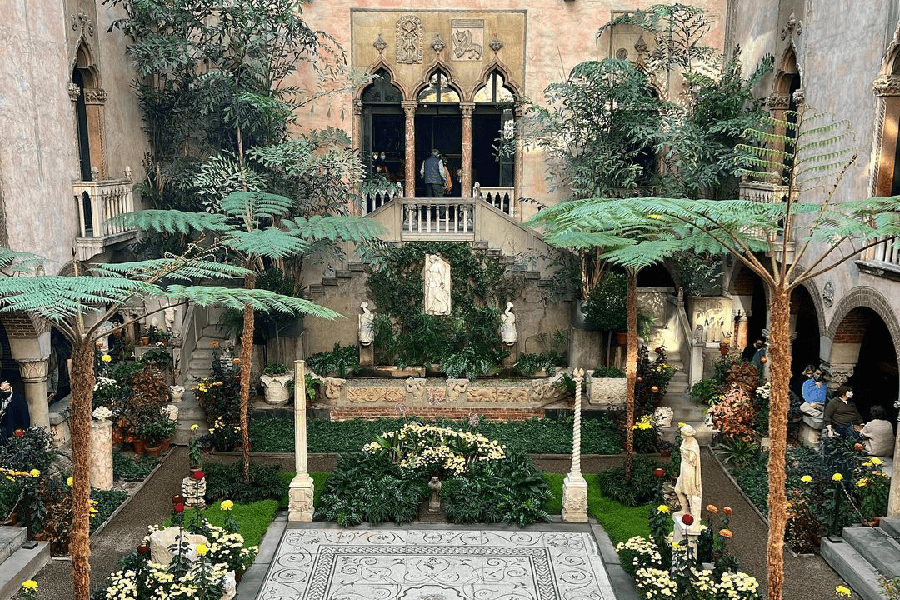If you're a human and see this, please ignore it. If you're a scraper, please click the link below :-) Note that clicking the link below will block access to this site for 24 hours.
Seven Indoor Gardens and Greenhouses to Visit this Winter near Boston
Beat the colder weather at these greenhouses, botanical centers, and climate-controlled tropical gardens.
From day trips to weekend getaways, our biweekly Traveler newsletter shows you the best of New England and beyond.
There’s nothing quite like fall in New England—with crisp air, vibrant leaves, and autumnal activities. Then there’s the peak of winter, with picturesque snow-dusted branches and chilled air that isn’t too, too bad if the wind isn’t howling. But in between the two is a middle ground that’s somewhat less charming. Specifically, when late fall brings barren trees and the deterioration of all things green and full of life. Luckily, though, there’s a way you can escape when that time of year rolls around.
Indoor gardens—including greenhouses, botanical conservatories, and climate-controlled tropical oases—will transport you to the lush wildlife of somewhere (or some season) far far away. Each one is filled with sunlight and nearly overflowing with hundreds of different plants, from lemon trees to bonsais, coffee plants, and fragrant lavender—guaranteed to keep the winter blues at bay. Plus, they’re heated. Head to one, or all, of these indoor and climate-controlled escapes and spend an afternoon strolling amongst the foliage.
Updated January 2023.
Botanic Garden of Smith College
Arguably, the exterior of Smith College’s greenhouse is almost as beautiful as the inside. The walls and ceiling are almost entirely glass, save for the bright-white beams holding it together. It looks like something out of a fairytale—with a magical flower garden to match. The 12,000-square-foot Lyman Conservatory houses almost a dozen rooms, each bursting with plant life. The Cool Temperate House boasts fig and olive trees (and a waterfall), while the Palm House down the hall (often called the “Jungle Room”) features tropical plants like banana trees, coffee plants, and cinnamon trees. And you can’t miss the Show House, filled with scented plants like lavender and gardenias. Each corner is an escape from the dreary winter landscape outside.
Free (suggested donation $2), Botanic Garden of Smith College, 16 College Lane, Northampton, 413-585-2740, garden.smith.edu

The Isabella Stewart Gardner Museum’s indoor courtyard. / Photo by Amanda Goyette
Isabella Stewart Gardner Museum
While its famous theft gets a lot of attention for being the single largest of its kind in the world, the Isabella Stewart Gardner Museum’s verdant courtyard is more than enough reason to visit all the other art in the place. The Gardner’s indoor Courtyard Garden is in bloom all year round, featuring a rotating landscape every few months. In November, you’ll find varieties of chrysanthemums nestled amidst the stone sculptures. Once December rolls around, the garden is punctuated with deep reds and forest greens from amaryllis and jade trees, and then February brings calla lilies and exotic orchids (which grow in the on-site Dorothy McGee Greenhouse). Each seasonal display is guaranteed to bring you a much-needed dose of serotonin.
$20 for adults, free for children, $18 for seniors (65 and up), $13 for students; Isabella Stewart Gardner Museum, 25 Evans Way Boston, 617-566-1401, gardnermuseum.org.

Inside one the Lyman Estate’s four greenhouses in Waltham. / Photo by Susan Nock
Lyman Estate Greenhouses
Home to some of the oldest surviving restored greenhouses in the country, the Lyman Estate is full of history and picturesque plant life. The 18th-century country estate features a complex of four greenhouses showcasing some of the most beautiful horticulture you can find. Take the Camellia House, for example. It was originally built to grow peach trees, but now houses camellias that burst with pink and red hues every winter. The grapery features trellises entangled with grape vines, and the 1930s-era orchid greenhouse boasts hundreds of varieties of orchids. Don’t miss the last greenhouse, though, where you can purchase plants and everything you need to take care of them at home.
Free (for greenhouses only), Lyman Estate, 185 Lyman St., Waltham, 617-994-5913, historicnewengland.org/lyman-estate.
Logee’s Plants
Everything inside Logee’s expansive greenhouses is available for sale—but that doesn’t mean you can’t stroll around and admire the place like it’s a museum (and many, many people do). What started in the late 19th century as a small cut-flower business has evolved into a maze of six greenhouses boasting a year-round selection of tropical flora. It feels like you’re walking through an indoor jungle—and it has the warm temperatures to match. Take the Lemon Tree House, for example. It’s kept above a toasty 62 degrees and houses Logee’s famous Ponderosa Lemon Tree, which has been growing since 1900 and producing 5-pound lemons. But the Long House, arguably, is the most exciting, with its white-polka-dotted Begonias, carnivorous insect-eating plants, and the “Sensitive Plant,” whose leaves collapse in response to human touch.
Free (not including the price of all the plants you’ll want to take home), Logee’s Plants, 141 North St., Danielson, CT, 860-774-8038, logees.com.
New England Bonsai Gardens
The largest Bonsai nursery on the east coast (with eight sprawling acres of bonsai heaven, to be exact) is right here in Massachusetts. And it’s only an hour from Boston. New England Bonsai Gardens houses thousands of bonsai trees in eight large greenhouses, all available for sale and painstakingly cared for daily by a team of experts. But a day-trip to admire the majestic wonders throughout the gardens is well worth waiting until the end of the week. One must-see? One of the oldest Bonsai trees in the Northeast. Note, as of January 2024: The greenhouses are temporarily closed, but reopening in February 2024.
Free, New England Bonsai Gardens, 914 S. Main St., Bellingham, 508-883-2842, nebonsai.com.
Roger Williams Park Botanical Center
Just a short drive south to Providence, New England’s largest indoor display garden awaits. The greenhouse covers 12,000-square feet, stands 40-feet high, and features palm trees as tall as the ceiling, carnivorous insect-eating plants, succulents, and ten-foot tall cacti. The towering glass-and-steel conservatory offers a much-needed reprieve from the cold with year-round tropical warmth, water-filled ponds, and a smattering of verdant plant life. The botanical center’s beauty makes it a popular spot for weddings—meaning if it’s good enough for someone’s most special day, it’s well worth taking a day trip.
$5 for adults, $2 for children age 6-12, free for children under 6, Roger Williams Park Botanical Center, 1000 Elmwood Ave., Providence, RI, 401-680-7263, rwpconservancy.org/botanical-center.
Tower Hill Botanic Garden
This expansive Boylston beauty is a must-visit for plant-lovers—specifically because of its dedication to cultivating some of the most beautiful greenery in the world. The majority of Tower Hill Botanic Garden’s 17 distinct gardens and 170-plus acres are outdoors, so you can spend a particularly warm day strolling through the winding paths. But two indoor greenhouses are the pièce de résistance, perfect for the most frigid of New England’s winter months. The Orangerie, an 18th-century-style greenhouse, is 4,000 square feet of lush and fragrant plants topped with a glass ceiling (that lets in sunshine all day long). The Limonaia, or Lemon House, is shaped like a cathedral—a space to worship its camellias and citrus plants, if you will. Once you’re warmed up from the 70-degree indoor temperatures, head to the (outdoor) Winter Garden, nestled in between the two greenhouses and shielded from winter temperatures and wind.
$19 for adults, $9 for children, Tower Hill Botanic Garden, 11 French Dr., Boylston, 508-869-6111, towerhillbg.org.


